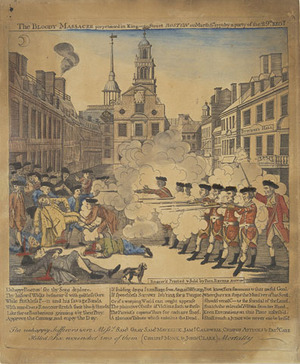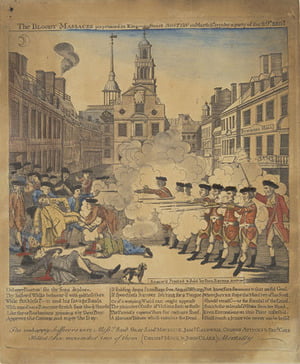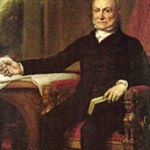In 1870, American patriots clashed with British soldiers in what came to be called the Boston Massacre. Protesting Boston’s occupation by British troops and taxation measures, colonists threw snowballs at British soldiers. After being hit, Private Hugh Montgomery fired into the crowd. The other British soldiers followed suit. Five colonists were killed, and two British soldiers were tried and found guilty of manslaughter. Interestingly, the punishment at the time was not jail time: both had their thumbs branded with the letter M. Future president John Adams represented one of the two soldiers at the trial.
The Boston Massacre, as the Sons of Liberty called it, became a propaganda tool for the American revolutionaries, including Paul Revere, whose famous (and somewhat biased) engraving was sent throughout the colonies.
Objectives
In this lesson, students will become familiar with the events of the Boston Massacre. They should also recognize and evaluate the role that the Boston Massacre played in rallying support for revolutionary efforts in the colonies, as well as recognize bias in many portrayals of the events of the Boston Massacre.
Anticipatory Set
Prior to completing the activities below, students should be familiar with the basic events of the Boston Massacre. Students should complete any required textbook readings on the Boston Massacre. Teachers can also supplement textbook readings by doing a class reading of a trade book on the Boston Massacre, of which
there are many commercially available.
Activity One: Evaluate a representation of The Boston Massacre
A great activity to help prepare students for document-based questions utilizes Paul Revere’s famous engraving. After reading textbook sections or trade books about the Boston Massacre, provide students with a color copy of Paul Revere’s engraving, such as the one provided by George Mason University. Allow the students a few minutes to discuss the engraving in small groups. Then, have students complete an Image Analysis Sheet, such as the one provided by the International Reading Association. After completing the Image Analysis Sheet, have groups complete their own illustration of the Boston Massacre, according to the factual descriptions previously read. Then, students should compare their drawing with Paul Revere’s engraving, using a Venn diagram.
Activity Two: Comparing Written Accounts of the Boston Massacre
Another good activity to help students understand the concept of bias is to have them compare two different colonial sources describing the events of the Boston Massacre. Begin by having students read a copy of the “Recollection of George Hewes”, which is made available by the Smithsonian Institution. Then, have students read an expert from A Household History for All Readers by Benson J. Lossing, also made available by the Smithsonian. Finally, have students compare and contrast the two accounts using a Venn diagram.
Assessment
Assess students by providing students with a different visual representation of the Boston Massacre, such as that by John Pufford. Ask students to explain the perspective from which the representation was made, and how bias might have affected the representation. In a paragraph, have students use factual details from their readings to support their position.
References:
This Day in History, The Boston Massacre, http://www.history.com
George Mason University, Boston Massacre, 1770, http://chnm.gmu.edu
Read Write Think, Using Pictures to Build Schema for Social Studies Content, http://www.readwritethink.org




